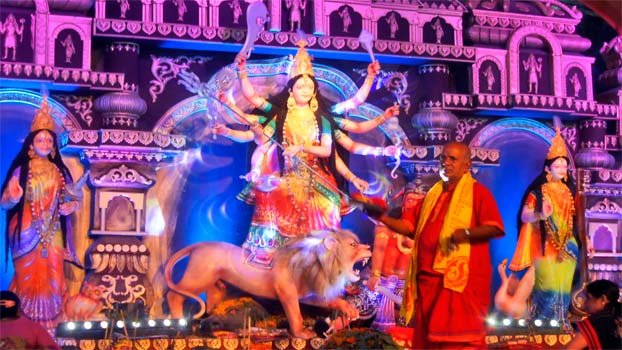Durga Puja: A walk down memory lane

Durga Puja is quite a festive tradition in the Indian subcontinent and as such it is celebrated with huge crowds and colours every year. Thinking back today I can remember how like any Bengali kid from Bengal and if you talk to any Bengali kid, from any part of this world, memories of Durga Puja shall always have a very special place from his/her childhood. May be that’s why they say, “You can take a Bengali out of Bengal, but you can never take Bengal out of a Bengali”.
My first childhood memory of Durga Puja, is of dhaak, shankha and display of exotic rituals, which made every Ashtami something to wait for. I remember Ma, dressing us up quickly and reaching the venue as early as 3pm so that we get to sit in the front row. Baba’s duty was to keep standing outside the crowds perimeter, because we kids would keep getting hungry and ma couldn’t afford to lose that spot she struggled so hard for us to sit.
Bengalis worship Shakti, and though Navratri is a nine day festival, for us it starts from shashti, sixth day, and ends with Bijaya Dashmi, tenth and last day. While in various places there are nine different forms of Shakti which are worshipped for nine days, one designated day for each, we Bengalis worship Ma Durga throughout the festival. According to Bengali tradition, it’s the home coming of Ma with her four kids, Ganesha, Kartik, Laxmi and Saraswati. Parvati the daughter of Himalaya, comes down to earth once every year, like a daughter visiting her Maayka (mother’s house). And this is the reason why Durga Puja for Bengalis, is a festival of new clothes and lots of food, specially sweets.

Bijaya Dashami, when we bid adieu to Ma with teary eyes and a promise to welcome her again next year with the same love and devotion. Since she visits us as the daughter, we do “boron” (aarti), apply aalta (red coloring on her feet)-sindoor to her and feed her sweets, just like how we would do when a married girl is leaving her parents home. We quietly whisper in her ears, “next year come soon”. The connection with Ma Durga is so intense, for us Bengalis, that this is the moment when most people quietly wipe tears off of their eyes. I do it too. Then begins the famous “Sindoor khela” , which has become such an important part of the cultural identity of Bengal. Women apply sindoor to each other and offer sweets. This part of Durga Puja was always very fascinating to me and I would always make my mother take me for sindoor khela.

Lastly, “thakur bhashan” or the immersion of idol, which forms a very important part of my Durga Puja memories all my life. The actual Bisarjan happens in a vessel of water with a mirror, kept in front of Ma, and everyone has a darshan of Ma in that mirror. It’s called darpan visarjan, which has to happen on a specific time, while the main moorti then can be taken in a procession for the Bisarjan. During my formative years we would walk all the way to the river for Bisarjan from the Puja Mandap. The cacophony of dhaak and shankha was enough to keep our spirits high for that long walk. Going with the procession for bisarjan is perhaps the one thing I miss the most every year.



